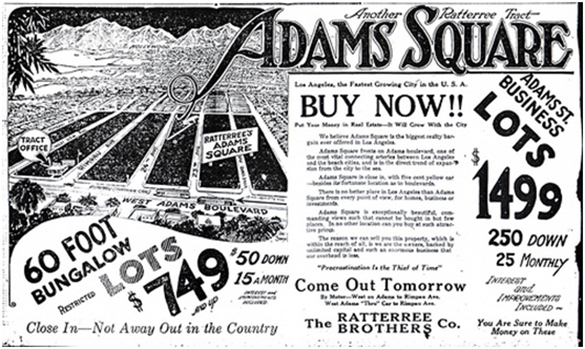| << Chapter < Page | Chapter >> Page > |
Advertising offers a useful window into the popular perceptions and beliefs of an era. By seeing how businesses were presenting their goods to consumers, it is possible to sense the hopes and aspirations of people at that moment in history. Maybe companies are selling patriotism or pride in technological advances. Maybe they are pushing idealized views of parenthood or safety. In the 1920s, advertisers were selling opportunity and euphoria, further feeding the notions of many Americans that prosperity would never end.
In the decade before the Great Depression, the optimism of the American public was seemingly boundless. Advertisements from that era show large new cars, timesaving labor devices, and, of course, land. This advertisement for California real estate illustrates how realtors in the West, much like the ongoing Florida land boom, used a combination of the hard sell and easy credit ( [link] ). “Buy now!!” the ad shouts. “You are sure to make money on these.” In great numbers, people did. With easy access to credit and hard-pushing advertisements like this one, many felt that they could not afford to miss out on such an opportunity. Unfortunately, overspeculation in California and hurricanes along the Gulf Coast and in Florida conspired to burst this land bubble, and would-be millionaires were left with nothing but the ads that once pulled them in.

The Florida land boom went bust in 1925–1926. A combination of negative press about the speculative nature of the boom, IRS investigations into the questionable financial practices of several land brokers, and a railroad embargo that limited the delivery of construction supplies into the region significantly hampered investor interest. The subsequent Great Miami Hurricane of 1926 drove most land developers into outright bankruptcy. However, speculation continued throughout the decade, this time in the stock market. Buyers purchased stock “on margin”—buying for a small down payment with borrowed money, with the intention of quickly selling at a much higher price before the remaining payment came due—which worked well as long as prices continued to rise. Speculators were aided by retail stock brokerage firms, which catered to average investors anxious to play the market but lacking direct ties to investment banking houses or larger brokerage firms. When prices began to fluctuate in the summer of 1929, investors sought excuses to continue their speculation. When fluctuations turned to outright and steady losses, everyone started to sell. As September began to unfold, the Dow Jones Industrial Average peaked at a value of 381 points, or roughly ten times the stock market’s value, at the start of the 1920s.

Notification Switch
Would you like to follow the 'U.s. history' conversation and receive update notifications?